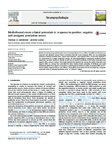Mediofrontal event-related potentials in response to positive, negative and unsigned prediction errors
| dc.contributor.author | Sambrook, TD | |
| dc.contributor.author | Goslin, Jeremy | |
| dc.date.accessioned | 2017-09-22T14:50:05Z | |
| dc.date.available | 2017-09-22T14:50:05Z | |
| dc.date.issued | 2014-08 | |
| dc.identifier.issn | 0028-3932 | |
| dc.identifier.issn | 1873-3514 | |
| dc.identifier.uri | http://hdl.handle.net/10026.1/9975 | |
| dc.description.abstract |
Reinforcement learning models make use of reward prediction errors (RPEs), the difference between an expected and obtained reward. There is evidence that the brain computes RPEs, but an outstanding question is whether positive RPEs ("better than expected") and negative RPEs ("worse than expected") are represented in a single integrated system. An electrophysiological component, feedback related negativity, has been claimed to encode an RPE but its relative sensitivity to the utility of positive and negative RPEs remains unclear. This study explored the question by varying the utility of positive and negative RPEs in a design that controlled for other closely related properties of feedback and could distinguish utility from salience. It revealed a mediofrontal sensitivity to utility, for positive RPEs at 275-310ms and for negative RPEs at 310-390ms. These effects were preceded and succeeded by a response consistent with an unsigned prediction error, or "salience" coding. | |
| dc.format.extent | 1-10 | |
| dc.format.medium | Print-Electronic | |
| dc.language | en | |
| dc.language.iso | eng | |
| dc.publisher | Elsevier BV | |
| dc.subject | Feedback related negativity (FRN) | |
| dc.subject | Event-related potential (ERP) | |
| dc.subject | Reward prediction error (RPE) | |
| dc.subject | Unsigned prediction error | |
| dc.subject | Saliency | |
| dc.subject | Dopamine | |
| dc.title | Mediofrontal event-related potentials in response to positive, negative and unsigned prediction errors | |
| dc.type | journal-article | |
| dc.type | Journal Article | |
| plymouth.author-url | https://www.webofscience.com/api/gateway?GWVersion=2&SrcApp=PARTNER_APP&SrcAuth=LinksAMR&KeyUT=WOS:000340980400001&DestLinkType=FullRecord&DestApp=ALL_WOS&UsrCustomerID=11bb513d99f797142bcfeffcc58ea008 | |
| plymouth.issue | 1 | |
| plymouth.volume | 61 | |
| plymouth.publication-status | Published | |
| plymouth.journal | Neuropsychologia | |
| dc.identifier.doi | 10.1016/j.neuropsychologia.2014.06.004 | |
| plymouth.organisational-group | /Plymouth | |
| plymouth.organisational-group | /Plymouth/Faculty of Health | |
| plymouth.organisational-group | /Plymouth/Faculty of Health/School of Psychology | |
| plymouth.organisational-group | /Plymouth/REF 2021 Researchers by UoA | |
| plymouth.organisational-group | /Plymouth/REF 2021 Researchers by UoA/UoA04 Psychology, Psychiatry and Neuroscience | |
| plymouth.organisational-group | /Plymouth/REF 2021 Researchers by UoA/UoA04 Psychology, Psychiatry and Neuroscience/UoA04 REF peer reviewers | |
| plymouth.organisational-group | /Plymouth/Research Groups | |
| plymouth.organisational-group | /Plymouth/Research Groups/Centre for Brain, Cognition and Behaviour (CBCB) | |
| plymouth.organisational-group | /Plymouth/Research Groups/Centre for Brain, Cognition and Behaviour (CBCB)/Brain | |
| plymouth.organisational-group | /Plymouth/Users by role | |
| plymouth.organisational-group | /Plymouth/Users by role/Academics | |
| dc.publisher.place | England | |
| dcterms.dateAccepted | 2014-06-06 | |
| dc.rights.embargodate | 2015-08-01 | |
| dc.identifier.eissn | 1873-3514 | |
| dc.rights.embargoperiod | 12 months | |
| rioxxterms.versionofrecord | 10.1016/j.neuropsychologia.2014.06.004 | |
| rioxxterms.licenseref.uri | http://www.rioxx.net/licenses/under-embargo-all-rights-reserved | |
| rioxxterms.licenseref.startdate | 2014-08 | |
| rioxxterms.type | Journal Article/Review |


